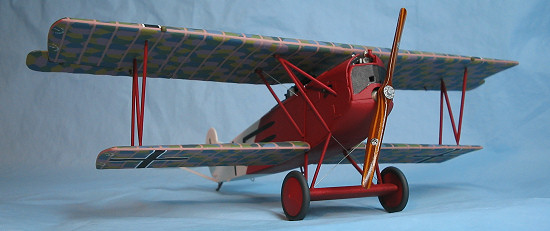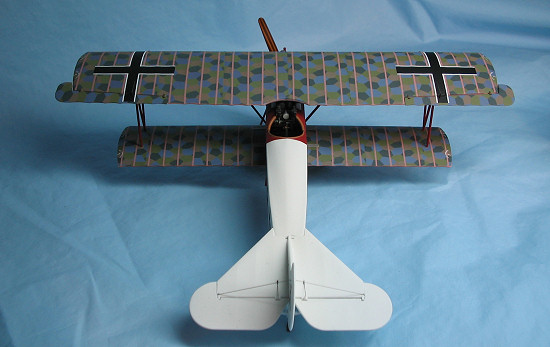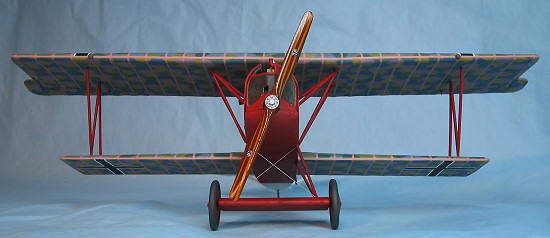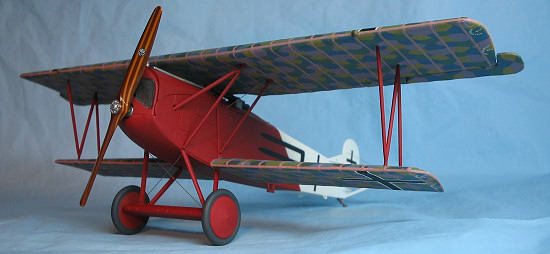
| KIT: | |
| KIT #: | ? |
| PRICE: | $? |
| DECALS: | See review |
| REVIEWER: | Dan Brennan |
| NOTES: |

| HISTORY |
Just a little background about myself. My name is Dan and I live with my wife in south suburban Alsip, just outside of Chicago. I have been building model kits for over 30 years, but the last 18 years have been solely concentrated on 1/72nd scale WW I and WW II aircraft. I have also built several of the Sweet and Platz 1/144th scale just to try them out. I have currently over 80 aircraft in my personal collection. I also belong to a small and very close knit group of fellow modelers. Our group is called the “Southwest Side Master Modelers Association”. We have a common interest, which is building model kits. We build aircraft, armor, and whatever strikes our fancy. We meet every 6 to 8 weeks at a member’s house to show off our work. Some meetings have a theme, which challenges our ability and keeps the spirit of building alive within us.
This was my first Roden 1/48th scale WW I aircraft that I have built. I chose this subject matter for a number of reasons. First, I enjoy WW I aircraft, the Fokker D VII is one of my favorites. Secondly, a larger scale requires a little more work such as detailing, this caused me to “push the envelope” so to speak. And finally, to build something a little larger in scale than I am used to.
| THE KIT |
Upon opening the box I was very impressed with the look
of the kit. The molding was nicely done. Very little flash was on this
particular kit. The instruction sheet is w ell printed. There were, in my opinion
a few areas of the instructions that should have been more detailed for the
placement of some parts. Finally, the decals, the choices were very nice for
this aircraft. I know in the past that Roden has had some problems with their
decals. Some say the decals are too thick. I didn’t want to chance using the
Roden decals. I opted to use aftermarket decals prior to building this kit. I
chose Eagle Strike Productions decals for the upper (48011) and lower (48012)
lozenge for the wings and their rib tapes (48013) as well. The scheme I was
going to do can be found on Eagle Strike Productions sheet (48188). I did
Aircraft No. 3 flown by Ltn. Josef Raesch of Jasta 43. The aircraft was half red
and half white with lozenge on both wings. A large “trident” or “pitch fork”
adorned the sides of the aircraft along with the standard German crosses. I
thought this scheme was colorful and would make a nice addition to my
collection.
ell printed. There were, in my opinion
a few areas of the instructions that should have been more detailed for the
placement of some parts. Finally, the decals, the choices were very nice for
this aircraft. I know in the past that Roden has had some problems with their
decals. Some say the decals are too thick. I didn’t want to chance using the
Roden decals. I opted to use aftermarket decals prior to building this kit. I
chose Eagle Strike Productions decals for the upper (48011) and lower (48012)
lozenge for the wings and their rib tapes (48013) as well. The scheme I was
going to do can be found on Eagle Strike Productions sheet (48188). I did
Aircraft No. 3 flown by Ltn. Josef Raesch of Jasta 43. The aircraft was half red
and half white with lozenge on both wings. A large “trident” or “pitch fork”
adorned the sides of the aircraft along with the standard German crosses. I
thought this scheme was colorful and would make a nice addition to my
collection.
Before building this kit I feel I have to warn you when assembling this kit. I have had some minor problems with other 1/72nd scale kits but this 1/48th scale kit does require test fitting of pieces prior to painting or gluing. I cannot stress that enough. We get complacent when building “better” kits because the pieces fit perfect. This is not the case with this particular kit. Not saying Roden kits are bad, they are done well and produce great subject matter. The need to test fit is very important.
| CONSTRUCTION |
Following the instruction, I started construction with the engine. This assembly went well. The engine was very nicely detailed and looked great once assembled and painted. Unfortunately, I chose an aircraft that had the upper cowls on, so the detailed engine gets lost under the covers.
The fuel tank came next. There was a bit of confusion as to the numbering of the parts. Roden had misprinted on the instructions, the filler tube part numbers. Part 6C is the tall one of which there is only one. Part 11B are the short ones which go on each side of the large middle filler tube. Again nicely done fuel tank but not visible on the completed kit.
 The interior comes next. The building is pretty
straight forward. You need to open the holes on the floor to accept the rudder
pedals and control stick. There is a “U” shaped notch on the rear of the floor
board to line up part 15B. Sand this down as the rod will not fit in the “U”
when you line up part 23B that fits in the hole.
The interior comes next. The building is pretty
straight forward. You need to open the holes on the floor to accept the rudder
pedals and control stick. There is a “U” shaped notch on the rear of the floor
board to line up part 15B. Sand this down as the rod will not fit in the “U”
when you line up part 23B that fits in the hole.
Next comes the tail assembly. This went together well, but again some sanding and test fitting were needed to make sure the parts lined up. I attached the control horns, part 7C at this time because the rear part of the plane is white. If you are building this plane using a lozenge scheme, hold off installing this part until the lozenge is in place.
The upper and lower wings were next on the instructions. The wings are nicely done, not over emphasizing the ribs. The scallops on the trailing edge of the wing as well were not over done. I held off attaching part 4C, the ailerons to the upper wing. I was doing a lozenge fabric covering to the wings and the positioning of the lozenge is different from the rest of the wing. I also held off putting on part 8C, the control horns until the lozenge was put on and this part glued in place to the wing.
The next assembly was the sub wing assembly. Roden gives you three options for this part depending on the variation you are building. Please check your references to make sure you choose the right one. I just painted the wheels at this time and set them aside to be installed later on in the assembly process.
The radiator comes next. The “shutter” is installed as indicated on the instructions. No problems here the fit and positioning were fine.
Now we come to a point, at least in my opinion that was very challenging. The nose assembly, if you follow the instructions, it should go together quite well. Remember this step gives you the option of building this assembly with or without the upper cowling that covers the engine. Once again, check your references as to whether or not the aircraft you are building had these covers on or not. Test fitting was a priority for this assembly, I also at this time painted the inside of these parts aluminum prior to assembly. The plane I was doing had the upper cowl covers (parts 3H and 4H) on, so I followed step 10a. The only problem I had were the engine mounts. Once in place it made it virtually impossible to install the engine properly. After some thinking and test fitting, I decided to remove the engine mounts (parts 24B and 26B) and mount the engine directly on the tabs of the side walls that the mounts were to have gone. This proved to be a simple solution that allowed the engine to fit nice and snug the way is should be. Once completed, I set this assembly aside to allow the glue to dry.
Next assembly was the rudder. Again test fitting proved to be helpful as some sanding was needed to help with the fit. These pieces were glued and then set aside for later installation.
Step 12 deals with the machine guns, forward cockpit cover and instrument panel. I painted the machine guns using Humbrol Gun Metal, which by the way look spectacular, and set them aside. I did the same with the instrument panel. Lacking, are decals for the dials of the instrument panel. Aftermarket dials could be added, or what I did was paint them white and left them alone.
 Next we move to the fuselage halves. The D VII’s came
from the factory with lozenge fabric covering the whole aircraft. This would be
visible on the side walls of the cockpit. The placement of lozenge decals could
be done at this time to replicate this. I first painted the metal frame tubing,
then measured and cut individual pieces of decal and positioned them inside the
framing. This was a time consuming job, but the end product looked great. You
can also place a decal over the entire inside of the fuselage wall, let dry and
just paint over the framework. Do whatever works best for you. Part 14B was
installed at this time but I’ll warn you now that the position of this part
needs to be below the locator pins, otherwise when installing the instrument
panel, you will knock this part off. So I carefully sanded the pins off, touched
up the paint, and installed this part a little lower and had no problem. Part 6A
also needs to have lozenge on it as well. This back wall required sanding as
well to make sure the fit was good. Do this prior to applying the lozenge decal.
I painted the seat a leather color and set it aside.
Next we move to the fuselage halves. The D VII’s came
from the factory with lozenge fabric covering the whole aircraft. This would be
visible on the side walls of the cockpit. The placement of lozenge decals could
be done at this time to replicate this. I first painted the metal frame tubing,
then measured and cut individual pieces of decal and positioned them inside the
framing. This was a time consuming job, but the end product looked great. You
can also place a decal over the entire inside of the fuselage wall, let dry and
just paint over the framework. Do whatever works best for you. Part 14B was
installed at this time but I’ll warn you now that the position of this part
needs to be below the locator pins, otherwise when installing the instrument
panel, you will knock this part off. So I carefully sanded the pins off, touched
up the paint, and installed this part a little lower and had no problem. Part 6A
also needs to have lozenge on it as well. This back wall required sanding as
well to make sure the fit was good. Do this prior to applying the lozenge decal.
I painted the seat a leather color and set it aside.
The floor of the cockpit was a little tricky. This part needed a lot of sanding on the sides prior to mounting it to the pins on the side walls. I test fit the fuselage halves with the cockpit assembly to make sure it fit. There were no locator pins on the fuselage halves so this assembly was a little tricky. They did not line up perfectly, but were close enough to where a push or nudge to line up prior to gluing would be necessary. When installing the seat you will notice the pins that come out from the fuselage sides for the seat to rest on are too short. A small thin piece of sheet styrene across these two pins will provide a nice bracket for the seat to rest on. At this time I added Eduard photo etched seatbelts. I painted them a linen color for the straps and silver for the buckles and hardware. The tail assembly from step 4 and 11 were installed at this time. Test fitting and some sanding were necessary to have a nice fit. I installed the gas tank and the forward cockpit cover. The trick here was to attach the fuel tank to the forward cockpit cover rather than the front wall of the fuselage. The filler tubes lined up well with the cover and I glued the tank in place and then onto the fuselage. Part 30B was painted and then installed. This assembly was then set aside to dry.
I then followed step 14a to attach the engine assembly to the main fuselage. This too required a lot of test fitting and sanding. Part 28B from step 9b was a little to long and did not line up with the bottom of the fuselage. That left large gaps on the sides where the two parts were to be joined. I sanded the lower part (28B) and test fit it many times until I achieved the proper fit. This took quite some time because I would sand a little at a time, test fit, then sand again to get it right.
 The next step was to install the lower wing to the
fuselage. Boy, what a job this was. Test fit, sand, test fit, sand. This had to
fit perfectly otherwise the lower wing would appear to have anhedral. After some
time, the sanding and test fitting paid off. The lower wing was installed and
then glued in place. The struts and upper wing were also part of this assembly.
But, because of the color scheme, were left off to be installed at a later time.
The next step was to install the lower wing to the
fuselage. Boy, what a job this was. Test fit, sand, test fit, sand. This had to
fit perfectly otherwise the lower wing would appear to have anhedral. After some
time, the sanding and test fitting paid off. The lower wing was installed and
then glued in place. The struts and upper wing were also part of this assembly.
But, because of the color scheme, were left off to be installed at a later time.
The next step was the installation of the wheel struts and sub wing assembly along with the grab loops and step. These were glued in place and painted along with the rear tail supports and tail skid. Remember the sub wing should be parallel to the bottom of the fuselage so test fit and make sure the position is correct before gluing.
At this time prior to installing the upper wing, I glued the machine guns, fuel gauge and tachometer in place. This would be very difficult to do if the wing were on. Also, one additional modification needs to be made. The exhaust pipe that comes out on the port side of the plane needs to be cut and angled slightly back. This will allow the cabane strut to clear the exhaust.
Now, let’s get back to installing the upper wing. As you can see, the inner cabane struts are quite intricate and doing those first is usually what I do. I decided to look at other reviews to see how they attached the upper wing. The outer “N” struts were installed first followed by the inner struts. So I decided that I would follow their suggestion. I glued the outer struts to the lower wing and let dry over night. The next day I began to install the inner struts. I test fitted the upper wing to the outer struts to make sure they lined up and were straight, they were. So, I proceeded to gluing the upper wing in place. Boy was I glad that I decided to do it that way. As it turns out, all the inner struts needed to be shortened to fit. This was done one at a time until all the struts were installed. I, of course painted these prior to installing, so I had to touch them up once done.
 The final installation was the propeller. Roden here
also gives you 3 variations of props. Check pictures and references as to which
prop to use as all 3 are different. I went for the laminated look. I painted the
whole prop a wood color. After drying I then took small thin strips of masking
tape and taped over the wood to give it the laminated look. I then painted a
darker brown color for contrast. I removed the masking tape and there it was it
looked great. I then used Tamiya clear orange and gave the prop a coating of
this color to replicate a varnished look. I painted the hub silver, gloss coated
the prop, let dry and added the Axial decals.
The final installation was the propeller. Roden here
also gives you 3 variations of props. Check pictures and references as to which
prop to use as all 3 are different. I went for the laminated look. I painted the
whole prop a wood color. After drying I then took small thin strips of masking
tape and taped over the wood to give it the laminated look. I then painted a
darker brown color for contrast. I removed the masking tape and there it was it
looked great. I then used Tamiya clear orange and gave the prop a coating of
this color to replicate a varnished look. I painted the hub silver, gloss coated
the prop, let dry and added the Axial decals.
Since this plane had minimal rigging, I decided to try something different other than stretched sprue. I bought some stainless steel wire from Sea Bird in .006 diameters. I measured, cut and glued the wire in place. This worked out well and looked great.
| COLORS & MARKINGS |
The decaling and painting process went well. Plan ahead when you paint or apply decals. It’s easier to decal or paint a part before it is installed in place. I used Testors Model Master and Humbrol colors along with Tamiya acrylic for the prop. The decals were from Eagle Strike Productions. The only airbrush I used was my reliable Badger 350 with a fine tip. The end result was from many hours of hard work. This project took me over 3 months to complete. The holidays cost me some building time, but I didn’t want to rush to finish this plane. Hopefully by the photo’s you see here, you would agree with me that it turned out rather well.
March 2006
| REFERENCES |
As far as references, the Fokker D VII Anthology Vol. 1, 2, & 3 were used along with the Squadron Signal in Action for the D VII.
If you would like your product reviewed fairly and fairly quickly, please contact the editor or see other details in the Note to Contributors.